Labour Market Dynamics: Impact on HR Planning at P&G
VerifiedAdded on 2022/08/21
|12
|4063
|22
Essay
AI Summary
This essay provides a comprehensive analysis of tight and loose labour markets, exploring their distinct characteristics and implications for human resource (HR) planning and talent management. It delves into the impact of these market conditions on resourcing strategies, employee retention, and workforce planning, with a specific focus on Procter & Gamble (P&G) as a case study. The essay examines how organizations adapt their HR practices to navigate the challenges and opportunities presented by both tight and loose labour markets, including recruitment, training, and employee development. It emphasizes the importance of understanding labour market dynamics for effective HR decision-making and organizational success. The essay also provides a critical evaluation of various HR planning activities and supports its analysis with academic and professional references.
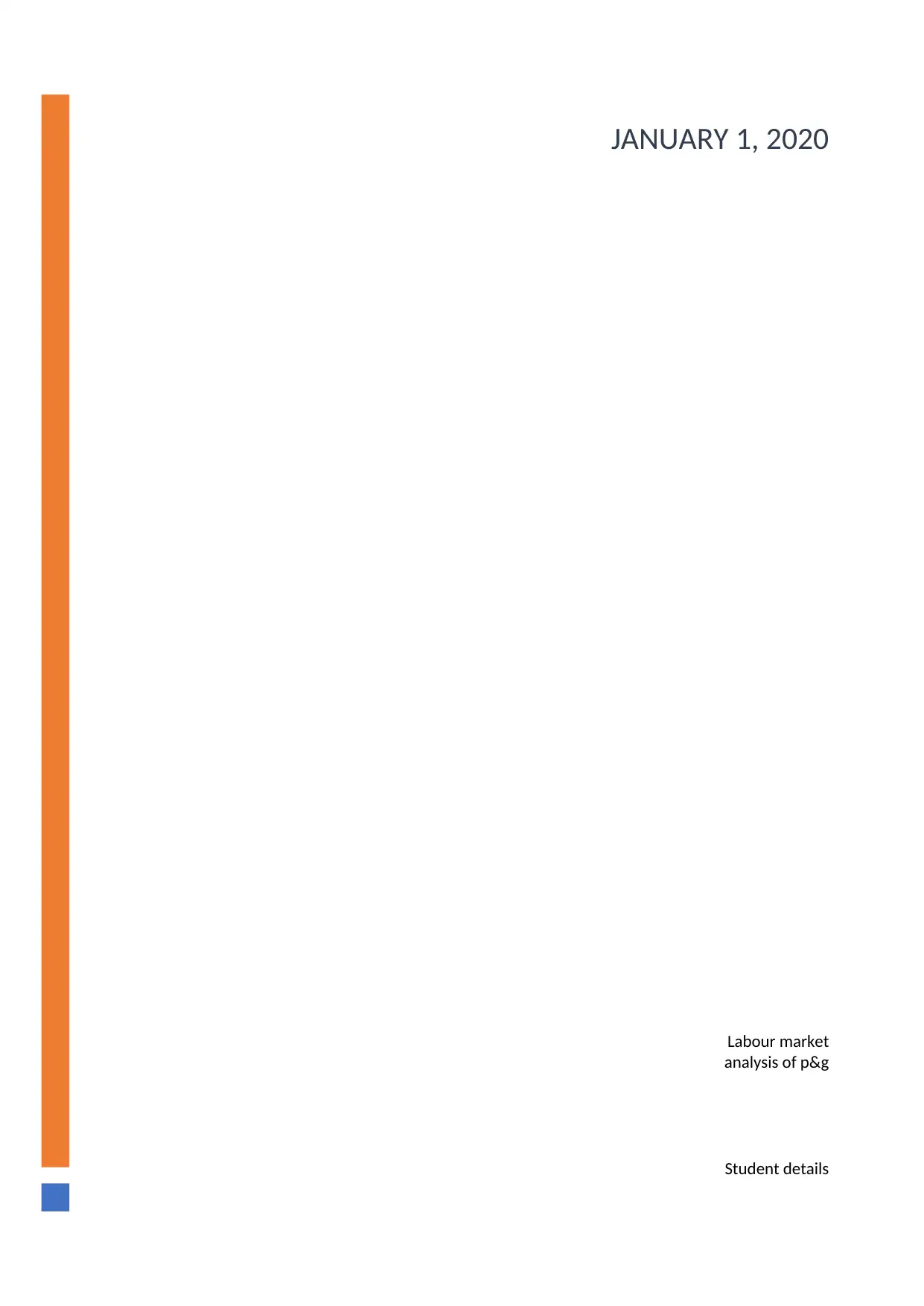
Labour market
analysis of p&g
Student details
JANUARY 1, 2020
analysis of p&g
Student details
JANUARY 1, 2020
Paraphrase This Document
Need a fresh take? Get an instant paraphrase of this document with our AI Paraphraser
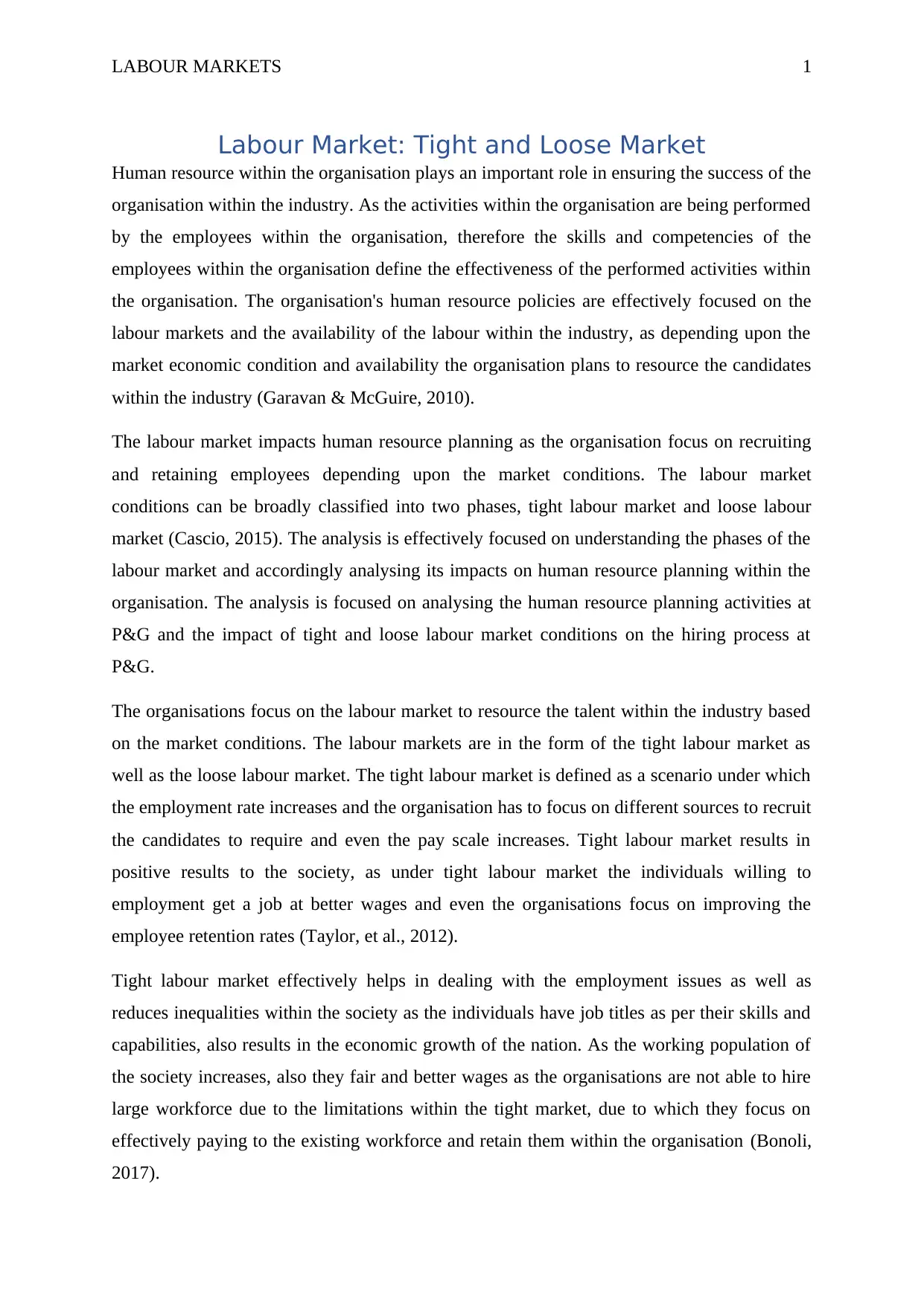
LABOUR MARKETS 1
Labour Market: Tight and Loose Market
Human resource within the organisation plays an important role in ensuring the success of the
organisation within the industry. As the activities within the organisation are being performed
by the employees within the organisation, therefore the skills and competencies of the
employees within the organisation define the effectiveness of the performed activities within
the organisation. The organisation's human resource policies are effectively focused on the
labour markets and the availability of the labour within the industry, as depending upon the
market economic condition and availability the organisation plans to resource the candidates
within the industry (Garavan & McGuire, 2010).
The labour market impacts human resource planning as the organisation focus on recruiting
and retaining employees depending upon the market conditions. The labour market
conditions can be broadly classified into two phases, tight labour market and loose labour
market (Cascio, 2015). The analysis is effectively focused on understanding the phases of the
labour market and accordingly analysing its impacts on human resource planning within the
organisation. The analysis is focused on analysing the human resource planning activities at
P&G and the impact of tight and loose labour market conditions on the hiring process at
P&G.
The organisations focus on the labour market to resource the talent within the industry based
on the market conditions. The labour markets are in the form of the tight labour market as
well as the loose labour market. The tight labour market is defined as a scenario under which
the employment rate increases and the organisation has to focus on different sources to recruit
the candidates to require and even the pay scale increases. Tight labour market results in
positive results to the society, as under tight labour market the individuals willing to
employment get a job at better wages and even the organisations focus on improving the
employee retention rates (Taylor, et al., 2012).
Tight labour market effectively helps in dealing with the employment issues as well as
reduces inequalities within the society as the individuals have job titles as per their skills and
capabilities, also results in the economic growth of the nation. As the working population of
the society increases, also they fair and better wages as the organisations are not able to hire
large workforce due to the limitations within the tight market, due to which they focus on
effectively paying to the existing workforce and retain them within the organisation (Bonoli,
2017).
Labour Market: Tight and Loose Market
Human resource within the organisation plays an important role in ensuring the success of the
organisation within the industry. As the activities within the organisation are being performed
by the employees within the organisation, therefore the skills and competencies of the
employees within the organisation define the effectiveness of the performed activities within
the organisation. The organisation's human resource policies are effectively focused on the
labour markets and the availability of the labour within the industry, as depending upon the
market economic condition and availability the organisation plans to resource the candidates
within the industry (Garavan & McGuire, 2010).
The labour market impacts human resource planning as the organisation focus on recruiting
and retaining employees depending upon the market conditions. The labour market
conditions can be broadly classified into two phases, tight labour market and loose labour
market (Cascio, 2015). The analysis is effectively focused on understanding the phases of the
labour market and accordingly analysing its impacts on human resource planning within the
organisation. The analysis is focused on analysing the human resource planning activities at
P&G and the impact of tight and loose labour market conditions on the hiring process at
P&G.
The organisations focus on the labour market to resource the talent within the industry based
on the market conditions. The labour markets are in the form of the tight labour market as
well as the loose labour market. The tight labour market is defined as a scenario under which
the employment rate increases and the organisation has to focus on different sources to recruit
the candidates to require and even the pay scale increases. Tight labour market results in
positive results to the society, as under tight labour market the individuals willing to
employment get a job at better wages and even the organisations focus on improving the
employee retention rates (Taylor, et al., 2012).
Tight labour market effectively helps in dealing with the employment issues as well as
reduces inequalities within the society as the individuals have job titles as per their skills and
capabilities, also results in the economic growth of the nation. As the working population of
the society increases, also they fair and better wages as the organisations are not able to hire
large workforce due to the limitations within the tight market, due to which they focus on
effectively paying to the existing workforce and retain them within the organisation (Bonoli,
2017).
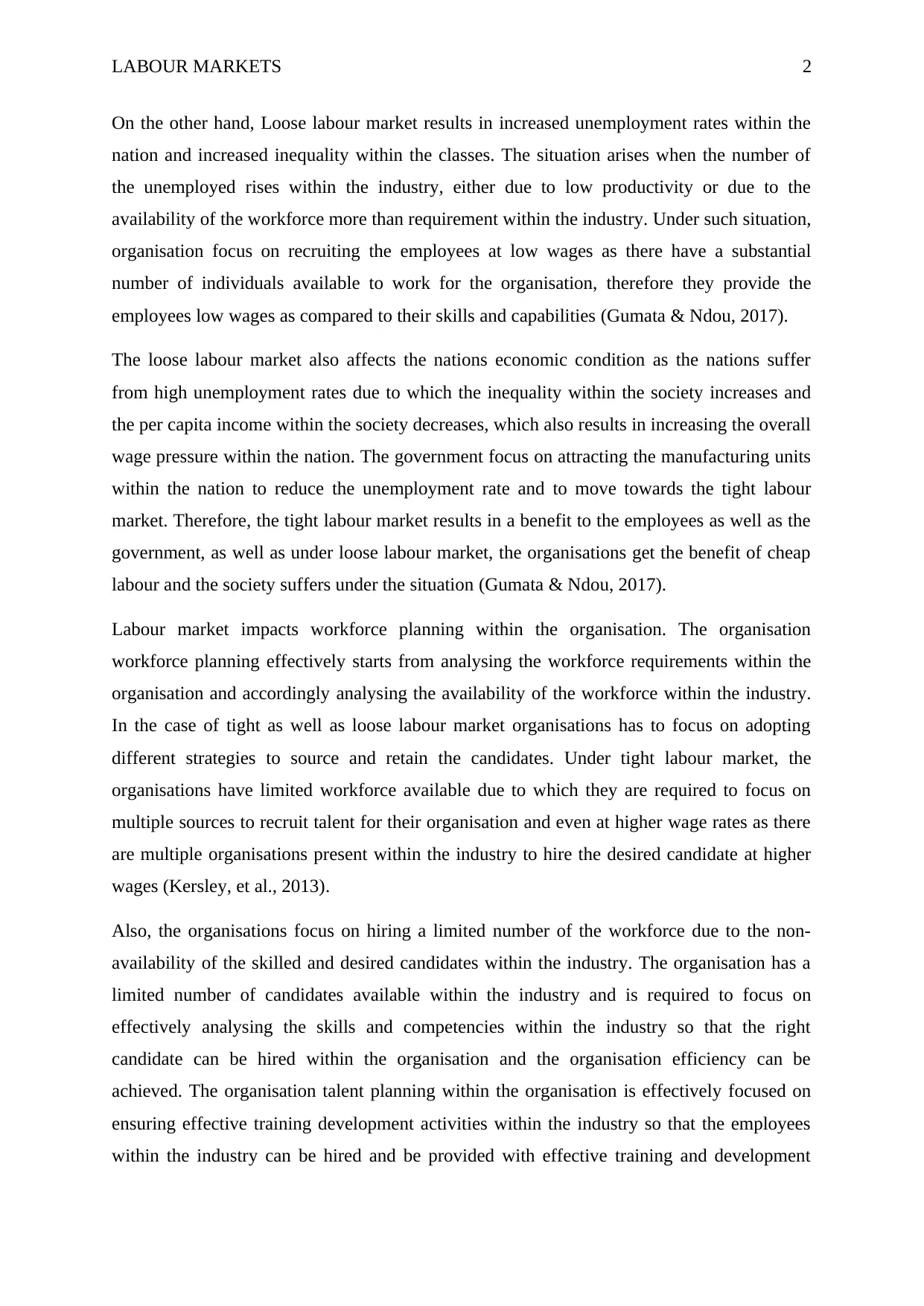
LABOUR MARKETS 2
On the other hand, Loose labour market results in increased unemployment rates within the
nation and increased inequality within the classes. The situation arises when the number of
the unemployed rises within the industry, either due to low productivity or due to the
availability of the workforce more than requirement within the industry. Under such situation,
organisation focus on recruiting the employees at low wages as there have a substantial
number of individuals available to work for the organisation, therefore they provide the
employees low wages as compared to their skills and capabilities (Gumata & Ndou, 2017).
The loose labour market also affects the nations economic condition as the nations suffer
from high unemployment rates due to which the inequality within the society increases and
the per capita income within the society decreases, which also results in increasing the overall
wage pressure within the nation. The government focus on attracting the manufacturing units
within the nation to reduce the unemployment rate and to move towards the tight labour
market. Therefore, the tight labour market results in a benefit to the employees as well as the
government, as well as under loose labour market, the organisations get the benefit of cheap
labour and the society suffers under the situation (Gumata & Ndou, 2017).
Labour market impacts workforce planning within the organisation. The organisation
workforce planning effectively starts from analysing the workforce requirements within the
organisation and accordingly analysing the availability of the workforce within the industry.
In the case of tight as well as loose labour market organisations has to focus on adopting
different strategies to source and retain the candidates. Under tight labour market, the
organisations have limited workforce available due to which they are required to focus on
multiple sources to recruit talent for their organisation and even at higher wage rates as there
are multiple organisations present within the industry to hire the desired candidate at higher
wages (Kersley, et al., 2013).
Also, the organisations focus on hiring a limited number of the workforce due to the non-
availability of the skilled and desired candidates within the industry. The organisation has a
limited number of candidates available within the industry and is required to focus on
effectively analysing the skills and competencies within the industry so that the right
candidate can be hired within the organisation and the organisation efficiency can be
achieved. The organisation talent planning within the organisation is effectively focused on
ensuring effective training development activities within the industry so that the employees
within the industry can be hired and be provided with effective training and development
On the other hand, Loose labour market results in increased unemployment rates within the
nation and increased inequality within the classes. The situation arises when the number of
the unemployed rises within the industry, either due to low productivity or due to the
availability of the workforce more than requirement within the industry. Under such situation,
organisation focus on recruiting the employees at low wages as there have a substantial
number of individuals available to work for the organisation, therefore they provide the
employees low wages as compared to their skills and capabilities (Gumata & Ndou, 2017).
The loose labour market also affects the nations economic condition as the nations suffer
from high unemployment rates due to which the inequality within the society increases and
the per capita income within the society decreases, which also results in increasing the overall
wage pressure within the nation. The government focus on attracting the manufacturing units
within the nation to reduce the unemployment rate and to move towards the tight labour
market. Therefore, the tight labour market results in a benefit to the employees as well as the
government, as well as under loose labour market, the organisations get the benefit of cheap
labour and the society suffers under the situation (Gumata & Ndou, 2017).
Labour market impacts workforce planning within the organisation. The organisation
workforce planning effectively starts from analysing the workforce requirements within the
organisation and accordingly analysing the availability of the workforce within the industry.
In the case of tight as well as loose labour market organisations has to focus on adopting
different strategies to source and retain the candidates. Under tight labour market, the
organisations have limited workforce available due to which they are required to focus on
multiple sources to recruit talent for their organisation and even at higher wage rates as there
are multiple organisations present within the industry to hire the desired candidate at higher
wages (Kersley, et al., 2013).
Also, the organisations focus on hiring a limited number of the workforce due to the non-
availability of the skilled and desired candidates within the industry. The organisation has a
limited number of candidates available within the industry and is required to focus on
effectively analysing the skills and competencies within the industry so that the right
candidate can be hired within the organisation and the organisation efficiency can be
achieved. The organisation talent planning within the organisation is effectively focused on
ensuring effective training development activities within the industry so that the employees
within the industry can be hired and be provided with effective training and development
⊘ This is a preview!⊘
Do you want full access?
Subscribe today to unlock all pages.

Trusted by 1+ million students worldwide
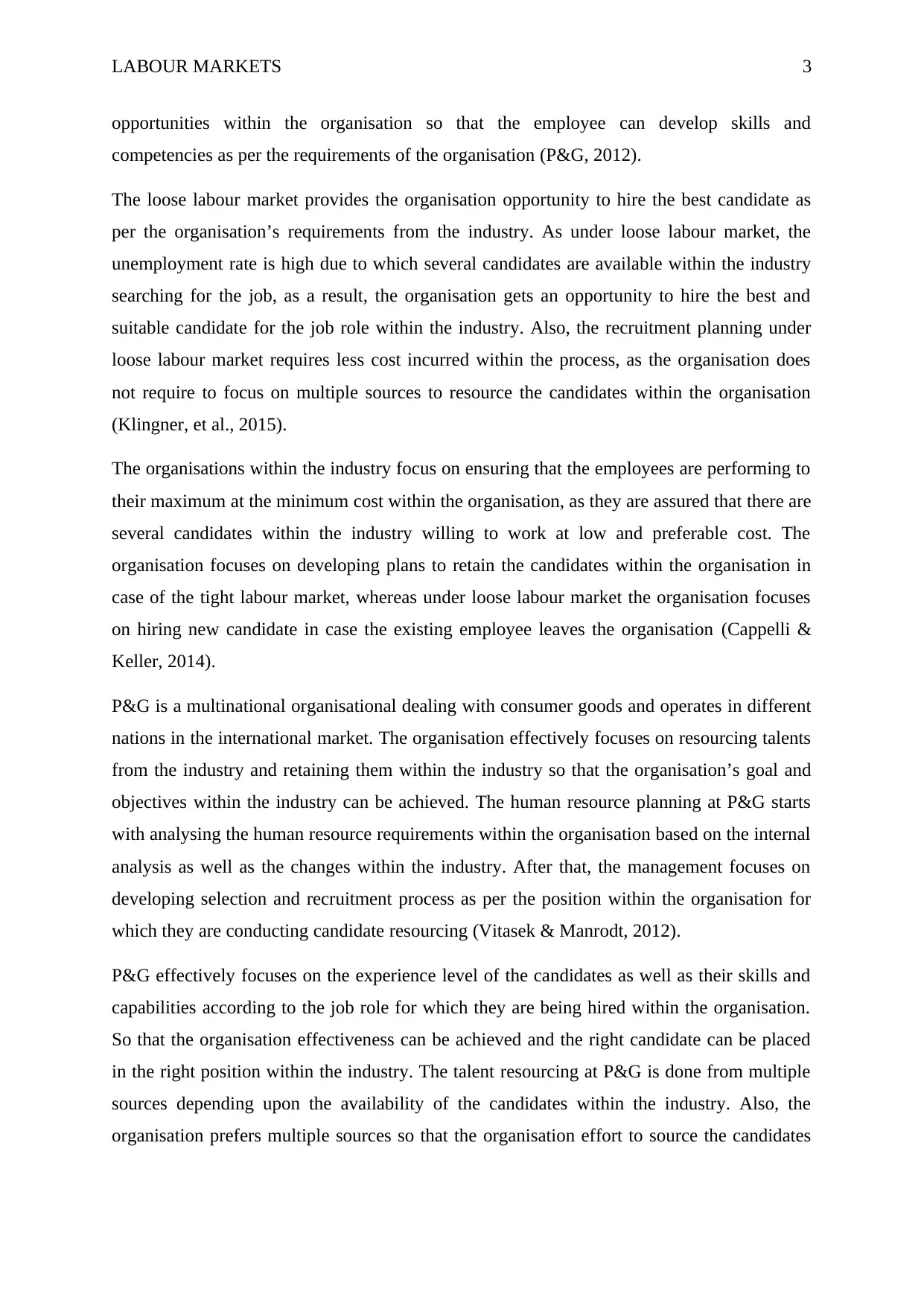
LABOUR MARKETS 3
opportunities within the organisation so that the employee can develop skills and
competencies as per the requirements of the organisation (P&G, 2012).
The loose labour market provides the organisation opportunity to hire the best candidate as
per the organisation’s requirements from the industry. As under loose labour market, the
unemployment rate is high due to which several candidates are available within the industry
searching for the job, as a result, the organisation gets an opportunity to hire the best and
suitable candidate for the job role within the industry. Also, the recruitment planning under
loose labour market requires less cost incurred within the process, as the organisation does
not require to focus on multiple sources to resource the candidates within the organisation
(Klingner, et al., 2015).
The organisations within the industry focus on ensuring that the employees are performing to
their maximum at the minimum cost within the organisation, as they are assured that there are
several candidates within the industry willing to work at low and preferable cost. The
organisation focuses on developing plans to retain the candidates within the organisation in
case of the tight labour market, whereas under loose labour market the organisation focuses
on hiring new candidate in case the existing employee leaves the organisation (Cappelli &
Keller, 2014).
P&G is a multinational organisational dealing with consumer goods and operates in different
nations in the international market. The organisation effectively focuses on resourcing talents
from the industry and retaining them within the industry so that the organisation’s goal and
objectives within the industry can be achieved. The human resource planning at P&G starts
with analysing the human resource requirements within the organisation based on the internal
analysis as well as the changes within the industry. After that, the management focuses on
developing selection and recruitment process as per the position within the organisation for
which they are conducting candidate resourcing (Vitasek & Manrodt, 2012).
P&G effectively focuses on the experience level of the candidates as well as their skills and
capabilities according to the job role for which they are being hired within the organisation.
So that the organisation effectiveness can be achieved and the right candidate can be placed
in the right position within the industry. The talent resourcing at P&G is done from multiple
sources depending upon the availability of the candidates within the industry. Also, the
organisation prefers multiple sources so that the organisation effort to source the candidates
opportunities within the organisation so that the employee can develop skills and
competencies as per the requirements of the organisation (P&G, 2012).
The loose labour market provides the organisation opportunity to hire the best candidate as
per the organisation’s requirements from the industry. As under loose labour market, the
unemployment rate is high due to which several candidates are available within the industry
searching for the job, as a result, the organisation gets an opportunity to hire the best and
suitable candidate for the job role within the industry. Also, the recruitment planning under
loose labour market requires less cost incurred within the process, as the organisation does
not require to focus on multiple sources to resource the candidates within the organisation
(Klingner, et al., 2015).
The organisations within the industry focus on ensuring that the employees are performing to
their maximum at the minimum cost within the organisation, as they are assured that there are
several candidates within the industry willing to work at low and preferable cost. The
organisation focuses on developing plans to retain the candidates within the organisation in
case of the tight labour market, whereas under loose labour market the organisation focuses
on hiring new candidate in case the existing employee leaves the organisation (Cappelli &
Keller, 2014).
P&G is a multinational organisational dealing with consumer goods and operates in different
nations in the international market. The organisation effectively focuses on resourcing talents
from the industry and retaining them within the industry so that the organisation’s goal and
objectives within the industry can be achieved. The human resource planning at P&G starts
with analysing the human resource requirements within the organisation based on the internal
analysis as well as the changes within the industry. After that, the management focuses on
developing selection and recruitment process as per the position within the organisation for
which they are conducting candidate resourcing (Vitasek & Manrodt, 2012).
P&G effectively focuses on the experience level of the candidates as well as their skills and
capabilities according to the job role for which they are being hired within the organisation.
So that the organisation effectiveness can be achieved and the right candidate can be placed
in the right position within the industry. The talent resourcing at P&G is done from multiple
sources depending upon the availability of the candidates within the industry. Also, the
organisation prefers multiple sources so that the organisation effort to source the candidates
Paraphrase This Document
Need a fresh take? Get an instant paraphrase of this document with our AI Paraphraser
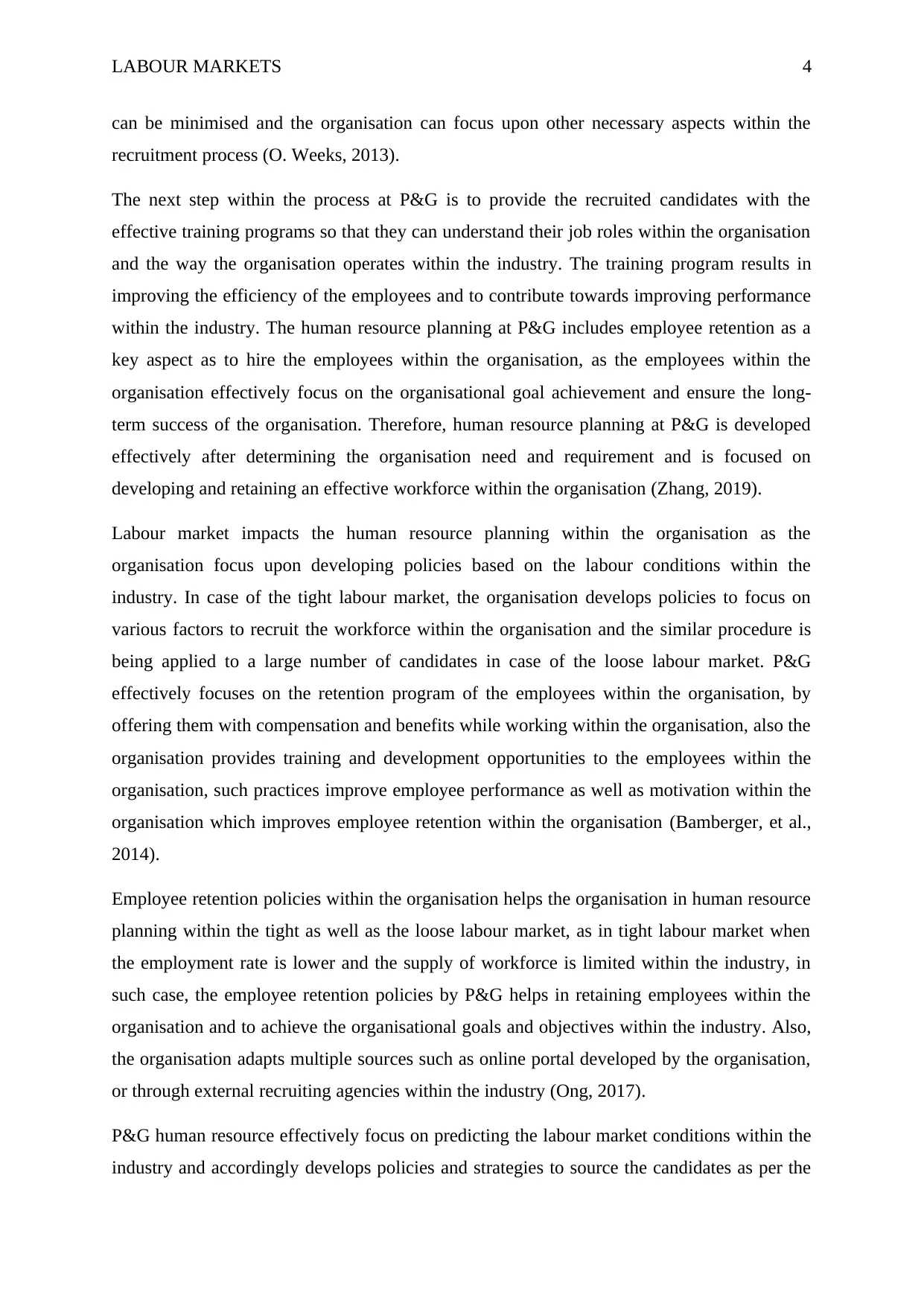
LABOUR MARKETS 4
can be minimised and the organisation can focus upon other necessary aspects within the
recruitment process (O. Weeks, 2013).
The next step within the process at P&G is to provide the recruited candidates with the
effective training programs so that they can understand their job roles within the organisation
and the way the organisation operates within the industry. The training program results in
improving the efficiency of the employees and to contribute towards improving performance
within the industry. The human resource planning at P&G includes employee retention as a
key aspect as to hire the employees within the organisation, as the employees within the
organisation effectively focus on the organisational goal achievement and ensure the long-
term success of the organisation. Therefore, human resource planning at P&G is developed
effectively after determining the organisation need and requirement and is focused on
developing and retaining an effective workforce within the organisation (Zhang, 2019).
Labour market impacts the human resource planning within the organisation as the
organisation focus upon developing policies based on the labour conditions within the
industry. In case of the tight labour market, the organisation develops policies to focus on
various factors to recruit the workforce within the organisation and the similar procedure is
being applied to a large number of candidates in case of the loose labour market. P&G
effectively focuses on the retention program of the employees within the organisation, by
offering them with compensation and benefits while working within the organisation, also the
organisation provides training and development opportunities to the employees within the
organisation, such practices improve employee performance as well as motivation within the
organisation which improves employee retention within the organisation (Bamberger, et al.,
2014).
Employee retention policies within the organisation helps the organisation in human resource
planning within the tight as well as the loose labour market, as in tight labour market when
the employment rate is lower and the supply of workforce is limited within the industry, in
such case, the employee retention policies by P&G helps in retaining employees within the
organisation and to achieve the organisational goals and objectives within the industry. Also,
the organisation adapts multiple sources such as online portal developed by the organisation,
or through external recruiting agencies within the industry (Ong, 2017).
P&G human resource effectively focus on predicting the labour market conditions within the
industry and accordingly develops policies and strategies to source the candidates as per the
can be minimised and the organisation can focus upon other necessary aspects within the
recruitment process (O. Weeks, 2013).
The next step within the process at P&G is to provide the recruited candidates with the
effective training programs so that they can understand their job roles within the organisation
and the way the organisation operates within the industry. The training program results in
improving the efficiency of the employees and to contribute towards improving performance
within the industry. The human resource planning at P&G includes employee retention as a
key aspect as to hire the employees within the organisation, as the employees within the
organisation effectively focus on the organisational goal achievement and ensure the long-
term success of the organisation. Therefore, human resource planning at P&G is developed
effectively after determining the organisation need and requirement and is focused on
developing and retaining an effective workforce within the organisation (Zhang, 2019).
Labour market impacts the human resource planning within the organisation as the
organisation focus upon developing policies based on the labour conditions within the
industry. In case of the tight labour market, the organisation develops policies to focus on
various factors to recruit the workforce within the organisation and the similar procedure is
being applied to a large number of candidates in case of the loose labour market. P&G
effectively focuses on the retention program of the employees within the organisation, by
offering them with compensation and benefits while working within the organisation, also the
organisation provides training and development opportunities to the employees within the
organisation, such practices improve employee performance as well as motivation within the
organisation which improves employee retention within the organisation (Bamberger, et al.,
2014).
Employee retention policies within the organisation helps the organisation in human resource
planning within the tight as well as the loose labour market, as in tight labour market when
the employment rate is lower and the supply of workforce is limited within the industry, in
such case, the employee retention policies by P&G helps in retaining employees within the
organisation and to achieve the organisational goals and objectives within the industry. Also,
the organisation adapts multiple sources such as online portal developed by the organisation,
or through external recruiting agencies within the industry (Ong, 2017).
P&G human resource effectively focus on predicting the labour market conditions within the
industry and accordingly develops policies and strategies to source the candidates as per the
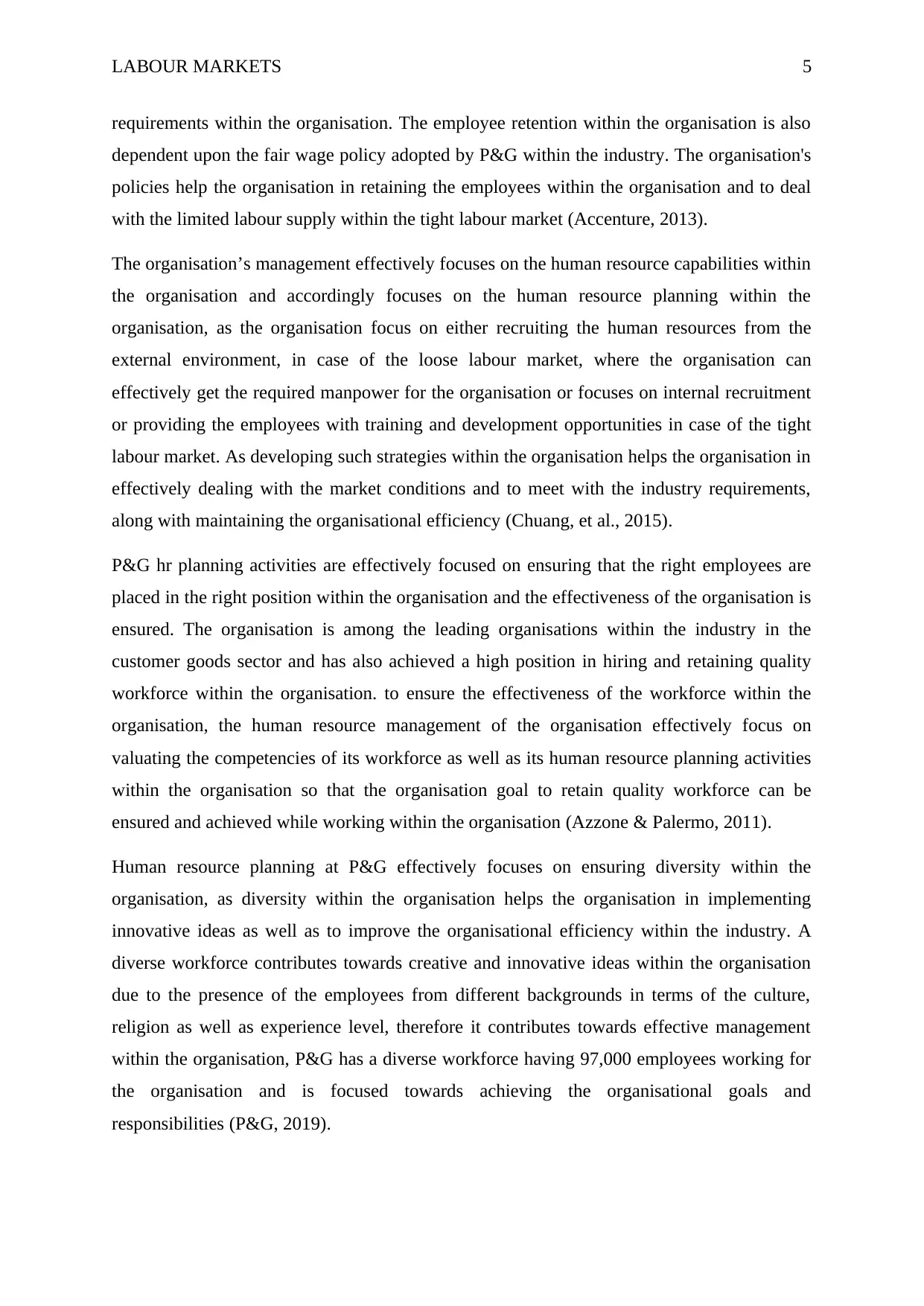
LABOUR MARKETS 5
requirements within the organisation. The employee retention within the organisation is also
dependent upon the fair wage policy adopted by P&G within the industry. The organisation's
policies help the organisation in retaining the employees within the organisation and to deal
with the limited labour supply within the tight labour market (Accenture, 2013).
The organisation’s management effectively focuses on the human resource capabilities within
the organisation and accordingly focuses on the human resource planning within the
organisation, as the organisation focus on either recruiting the human resources from the
external environment, in case of the loose labour market, where the organisation can
effectively get the required manpower for the organisation or focuses on internal recruitment
or providing the employees with training and development opportunities in case of the tight
labour market. As developing such strategies within the organisation helps the organisation in
effectively dealing with the market conditions and to meet with the industry requirements,
along with maintaining the organisational efficiency (Chuang, et al., 2015).
P&G hr planning activities are effectively focused on ensuring that the right employees are
placed in the right position within the organisation and the effectiveness of the organisation is
ensured. The organisation is among the leading organisations within the industry in the
customer goods sector and has also achieved a high position in hiring and retaining quality
workforce within the organisation. to ensure the effectiveness of the workforce within the
organisation, the human resource management of the organisation effectively focus on
valuating the competencies of its workforce as well as its human resource planning activities
within the organisation so that the organisation goal to retain quality workforce can be
ensured and achieved while working within the organisation (Azzone & Palermo, 2011).
Human resource planning at P&G effectively focuses on ensuring diversity within the
organisation, as diversity within the organisation helps the organisation in implementing
innovative ideas as well as to improve the organisational efficiency within the industry. A
diverse workforce contributes towards creative and innovative ideas within the organisation
due to the presence of the employees from different backgrounds in terms of the culture,
religion as well as experience level, therefore it contributes towards effective management
within the organisation, P&G has a diverse workforce having 97,000 employees working for
the organisation and is focused towards achieving the organisational goals and
responsibilities (P&G, 2019).
requirements within the organisation. The employee retention within the organisation is also
dependent upon the fair wage policy adopted by P&G within the industry. The organisation's
policies help the organisation in retaining the employees within the organisation and to deal
with the limited labour supply within the tight labour market (Accenture, 2013).
The organisation’s management effectively focuses on the human resource capabilities within
the organisation and accordingly focuses on the human resource planning within the
organisation, as the organisation focus on either recruiting the human resources from the
external environment, in case of the loose labour market, where the organisation can
effectively get the required manpower for the organisation or focuses on internal recruitment
or providing the employees with training and development opportunities in case of the tight
labour market. As developing such strategies within the organisation helps the organisation in
effectively dealing with the market conditions and to meet with the industry requirements,
along with maintaining the organisational efficiency (Chuang, et al., 2015).
P&G hr planning activities are effectively focused on ensuring that the right employees are
placed in the right position within the organisation and the effectiveness of the organisation is
ensured. The organisation is among the leading organisations within the industry in the
customer goods sector and has also achieved a high position in hiring and retaining quality
workforce within the organisation. to ensure the effectiveness of the workforce within the
organisation, the human resource management of the organisation effectively focus on
valuating the competencies of its workforce as well as its human resource planning activities
within the organisation so that the organisation goal to retain quality workforce can be
ensured and achieved while working within the organisation (Azzone & Palermo, 2011).
Human resource planning at P&G effectively focuses on ensuring diversity within the
organisation, as diversity within the organisation helps the organisation in implementing
innovative ideas as well as to improve the organisational efficiency within the industry. A
diverse workforce contributes towards creative and innovative ideas within the organisation
due to the presence of the employees from different backgrounds in terms of the culture,
religion as well as experience level, therefore it contributes towards effective management
within the organisation, P&G has a diverse workforce having 97,000 employees working for
the organisation and is focused towards achieving the organisational goals and
responsibilities (P&G, 2019).
⊘ This is a preview!⊘
Do you want full access?
Subscribe today to unlock all pages.

Trusted by 1+ million students worldwide
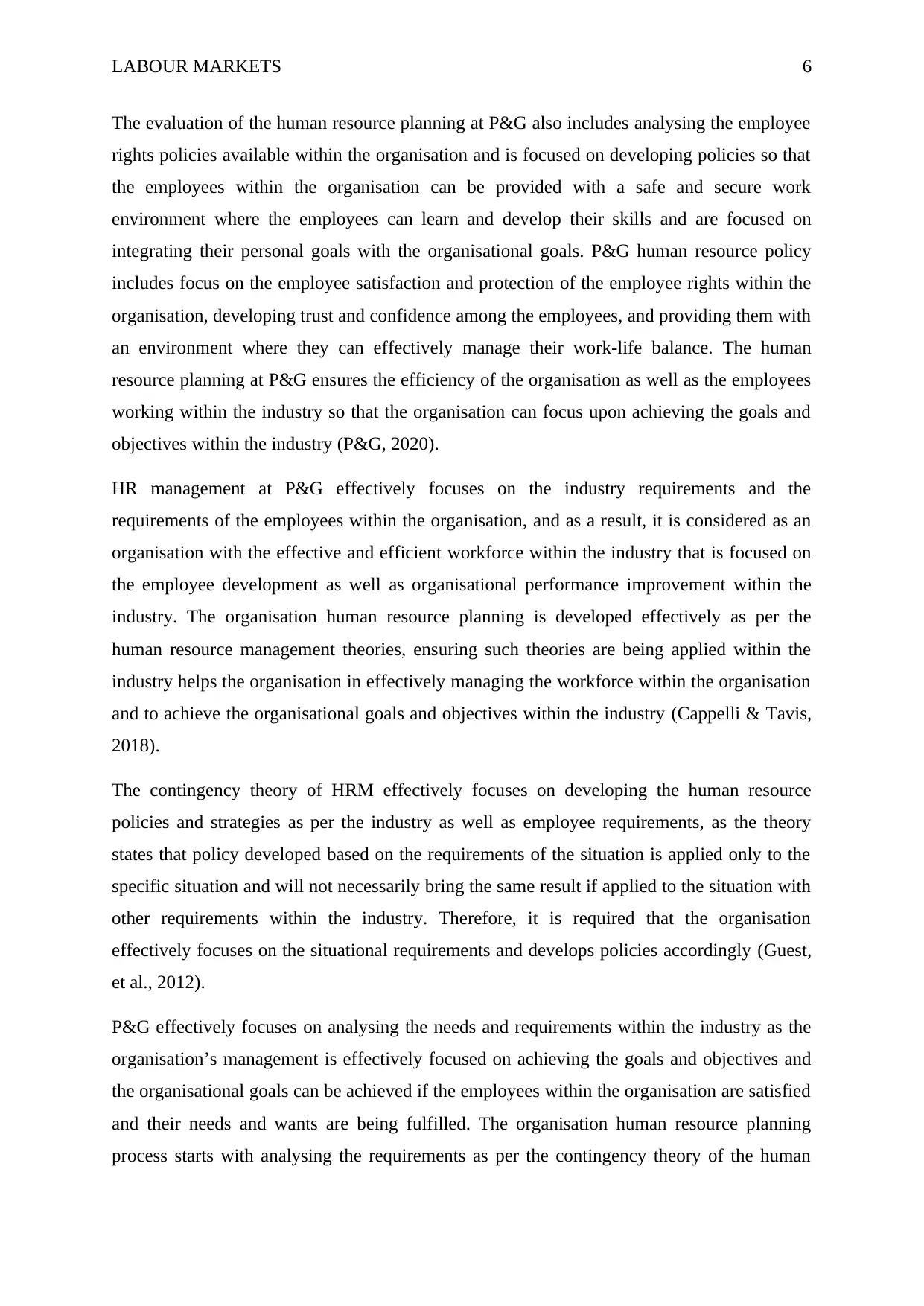
LABOUR MARKETS 6
The evaluation of the human resource planning at P&G also includes analysing the employee
rights policies available within the organisation and is focused on developing policies so that
the employees within the organisation can be provided with a safe and secure work
environment where the employees can learn and develop their skills and are focused on
integrating their personal goals with the organisational goals. P&G human resource policy
includes focus on the employee satisfaction and protection of the employee rights within the
organisation, developing trust and confidence among the employees, and providing them with
an environment where they can effectively manage their work-life balance. The human
resource planning at P&G ensures the efficiency of the organisation as well as the employees
working within the industry so that the organisation can focus upon achieving the goals and
objectives within the industry (P&G, 2020).
HR management at P&G effectively focuses on the industry requirements and the
requirements of the employees within the organisation, and as a result, it is considered as an
organisation with the effective and efficient workforce within the industry that is focused on
the employee development as well as organisational performance improvement within the
industry. The organisation human resource planning is developed effectively as per the
human resource management theories, ensuring such theories are being applied within the
industry helps the organisation in effectively managing the workforce within the organisation
and to achieve the organisational goals and objectives within the industry (Cappelli & Tavis,
2018).
The contingency theory of HRM effectively focuses on developing the human resource
policies and strategies as per the industry as well as employee requirements, as the theory
states that policy developed based on the requirements of the situation is applied only to the
specific situation and will not necessarily bring the same result if applied to the situation with
other requirements within the industry. Therefore, it is required that the organisation
effectively focuses on the situational requirements and develops policies accordingly (Guest,
et al., 2012).
P&G effectively focuses on analysing the needs and requirements within the industry as the
organisation’s management is effectively focused on achieving the goals and objectives and
the organisational goals can be achieved if the employees within the organisation are satisfied
and their needs and wants are being fulfilled. The organisation human resource planning
process starts with analysing the requirements as per the contingency theory of the human
The evaluation of the human resource planning at P&G also includes analysing the employee
rights policies available within the organisation and is focused on developing policies so that
the employees within the organisation can be provided with a safe and secure work
environment where the employees can learn and develop their skills and are focused on
integrating their personal goals with the organisational goals. P&G human resource policy
includes focus on the employee satisfaction and protection of the employee rights within the
organisation, developing trust and confidence among the employees, and providing them with
an environment where they can effectively manage their work-life balance. The human
resource planning at P&G ensures the efficiency of the organisation as well as the employees
working within the industry so that the organisation can focus upon achieving the goals and
objectives within the industry (P&G, 2020).
HR management at P&G effectively focuses on the industry requirements and the
requirements of the employees within the organisation, and as a result, it is considered as an
organisation with the effective and efficient workforce within the industry that is focused on
the employee development as well as organisational performance improvement within the
industry. The organisation human resource planning is developed effectively as per the
human resource management theories, ensuring such theories are being applied within the
industry helps the organisation in effectively managing the workforce within the organisation
and to achieve the organisational goals and objectives within the industry (Cappelli & Tavis,
2018).
The contingency theory of HRM effectively focuses on developing the human resource
policies and strategies as per the industry as well as employee requirements, as the theory
states that policy developed based on the requirements of the situation is applied only to the
specific situation and will not necessarily bring the same result if applied to the situation with
other requirements within the industry. Therefore, it is required that the organisation
effectively focuses on the situational requirements and develops policies accordingly (Guest,
et al., 2012).
P&G effectively focuses on analysing the needs and requirements within the industry as the
organisation’s management is effectively focused on achieving the goals and objectives and
the organisational goals can be achieved if the employees within the organisation are satisfied
and their needs and wants are being fulfilled. The organisation human resource planning
process starts with analysing the requirements as per the contingency theory of the human
Paraphrase This Document
Need a fresh take? Get an instant paraphrase of this document with our AI Paraphraser
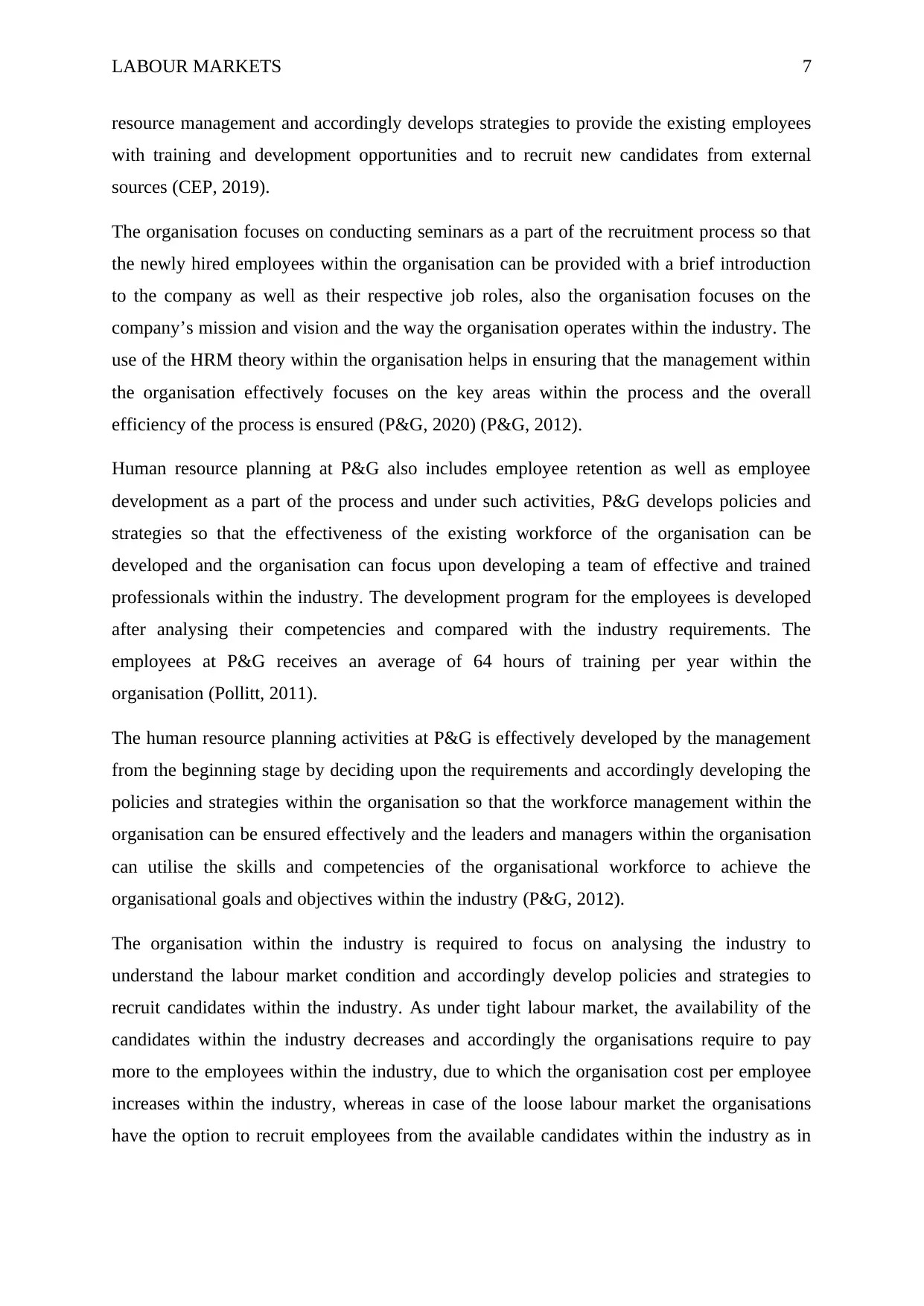
LABOUR MARKETS 7
resource management and accordingly develops strategies to provide the existing employees
with training and development opportunities and to recruit new candidates from external
sources (CEP, 2019).
The organisation focuses on conducting seminars as a part of the recruitment process so that
the newly hired employees within the organisation can be provided with a brief introduction
to the company as well as their respective job roles, also the organisation focuses on the
company’s mission and vision and the way the organisation operates within the industry. The
use of the HRM theory within the organisation helps in ensuring that the management within
the organisation effectively focuses on the key areas within the process and the overall
efficiency of the process is ensured (P&G, 2020) (P&G, 2012).
Human resource planning at P&G also includes employee retention as well as employee
development as a part of the process and under such activities, P&G develops policies and
strategies so that the effectiveness of the existing workforce of the organisation can be
developed and the organisation can focus upon developing a team of effective and trained
professionals within the industry. The development program for the employees is developed
after analysing their competencies and compared with the industry requirements. The
employees at P&G receives an average of 64 hours of training per year within the
organisation (Pollitt, 2011).
The human resource planning activities at P&G is effectively developed by the management
from the beginning stage by deciding upon the requirements and accordingly developing the
policies and strategies within the organisation so that the workforce management within the
organisation can be ensured effectively and the leaders and managers within the organisation
can utilise the skills and competencies of the organisational workforce to achieve the
organisational goals and objectives within the industry (P&G, 2012).
The organisation within the industry is required to focus on analysing the industry to
understand the labour market condition and accordingly develop policies and strategies to
recruit candidates within the industry. As under tight labour market, the availability of the
candidates within the industry decreases and accordingly the organisations require to pay
more to the employees within the industry, due to which the organisation cost per employee
increases within the industry, whereas in case of the loose labour market the organisations
have the option to recruit employees from the available candidates within the industry as in
resource management and accordingly develops strategies to provide the existing employees
with training and development opportunities and to recruit new candidates from external
sources (CEP, 2019).
The organisation focuses on conducting seminars as a part of the recruitment process so that
the newly hired employees within the organisation can be provided with a brief introduction
to the company as well as their respective job roles, also the organisation focuses on the
company’s mission and vision and the way the organisation operates within the industry. The
use of the HRM theory within the organisation helps in ensuring that the management within
the organisation effectively focuses on the key areas within the process and the overall
efficiency of the process is ensured (P&G, 2020) (P&G, 2012).
Human resource planning at P&G also includes employee retention as well as employee
development as a part of the process and under such activities, P&G develops policies and
strategies so that the effectiveness of the existing workforce of the organisation can be
developed and the organisation can focus upon developing a team of effective and trained
professionals within the industry. The development program for the employees is developed
after analysing their competencies and compared with the industry requirements. The
employees at P&G receives an average of 64 hours of training per year within the
organisation (Pollitt, 2011).
The human resource planning activities at P&G is effectively developed by the management
from the beginning stage by deciding upon the requirements and accordingly developing the
policies and strategies within the organisation so that the workforce management within the
organisation can be ensured effectively and the leaders and managers within the organisation
can utilise the skills and competencies of the organisational workforce to achieve the
organisational goals and objectives within the industry (P&G, 2012).
The organisation within the industry is required to focus on analysing the industry to
understand the labour market condition and accordingly develop policies and strategies to
recruit candidates within the industry. As under tight labour market, the availability of the
candidates within the industry decreases and accordingly the organisations require to pay
more to the employees within the industry, due to which the organisation cost per employee
increases within the industry, whereas in case of the loose labour market the organisations
have the option to recruit employees from the available candidates within the industry as in
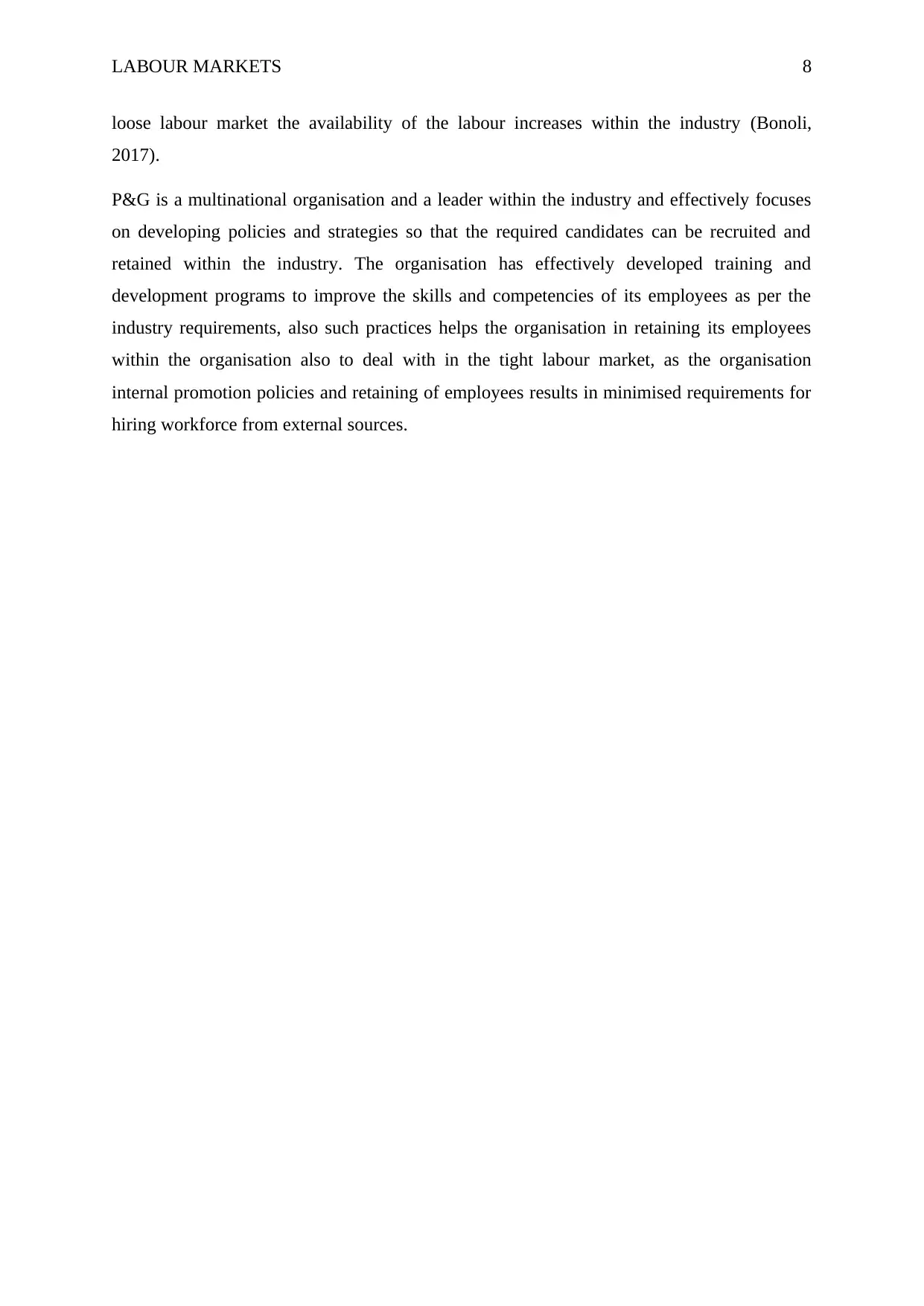
LABOUR MARKETS 8
loose labour market the availability of the labour increases within the industry (Bonoli,
2017).
P&G is a multinational organisation and a leader within the industry and effectively focuses
on developing policies and strategies so that the required candidates can be recruited and
retained within the industry. The organisation has effectively developed training and
development programs to improve the skills and competencies of its employees as per the
industry requirements, also such practices helps the organisation in retaining its employees
within the organisation also to deal with in the tight labour market, as the organisation
internal promotion policies and retaining of employees results in minimised requirements for
hiring workforce from external sources.
loose labour market the availability of the labour increases within the industry (Bonoli,
2017).
P&G is a multinational organisation and a leader within the industry and effectively focuses
on developing policies and strategies so that the required candidates can be recruited and
retained within the industry. The organisation has effectively developed training and
development programs to improve the skills and competencies of its employees as per the
industry requirements, also such practices helps the organisation in retaining its employees
within the organisation also to deal with in the tight labour market, as the organisation
internal promotion policies and retaining of employees results in minimised requirements for
hiring workforce from external sources.
⊘ This is a preview!⊘
Do you want full access?
Subscribe today to unlock all pages.

Trusted by 1+ million students worldwide
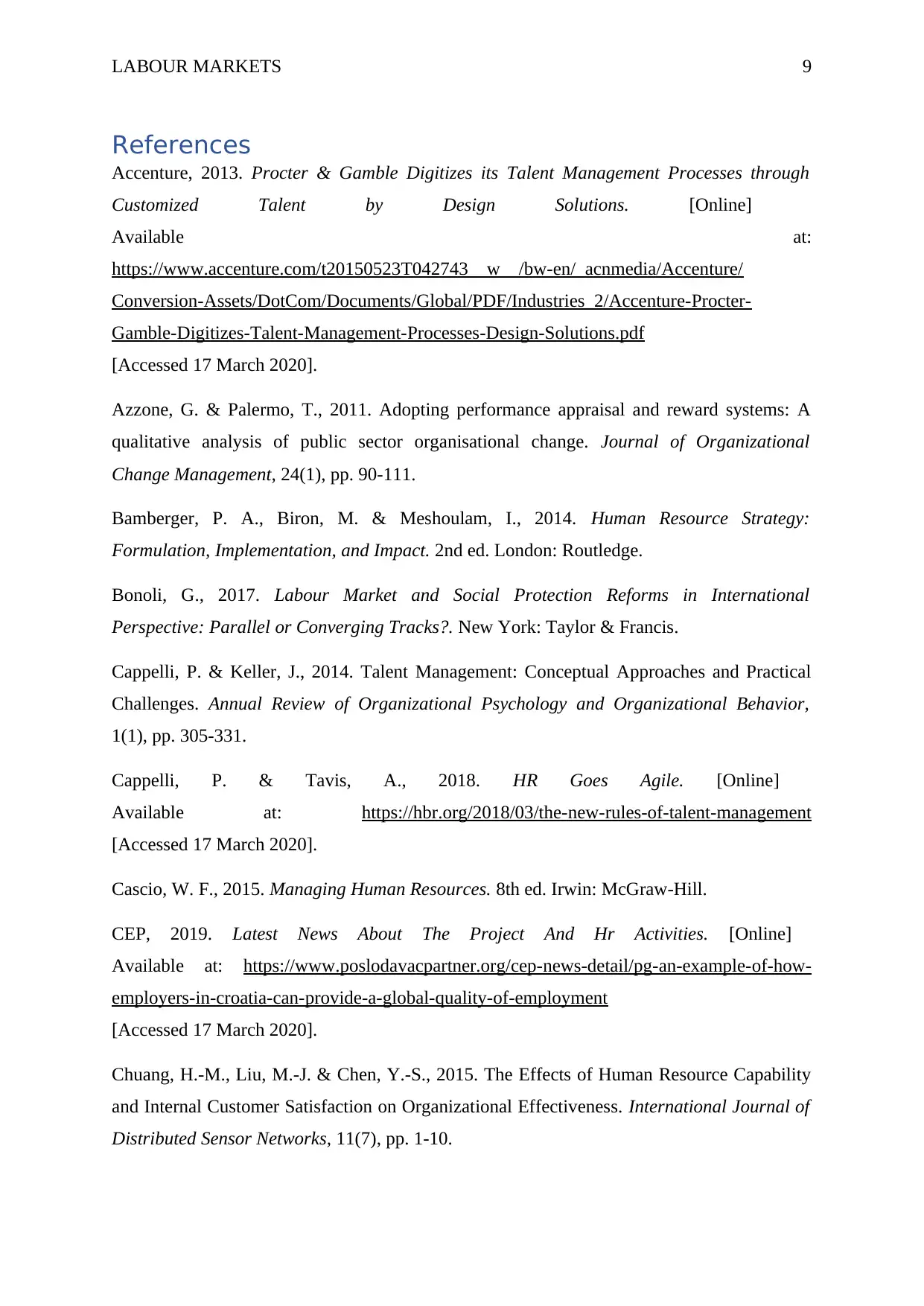
LABOUR MARKETS 9
References
Accenture, 2013. Procter & Gamble Digitizes its Talent Management Processes through
Customized Talent by Design Solutions. [Online]
Available at:
https://www.accenture.com/t20150523T042743__w__/bw-en/_acnmedia/Accenture/
Conversion-Assets/DotCom/Documents/Global/PDF/Industries_2/Accenture-Procter-
Gamble-Digitizes-Talent-Management-Processes-Design-Solutions.pdf
[Accessed 17 March 2020].
Azzone, G. & Palermo, T., 2011. Adopting performance appraisal and reward systems: A
qualitative analysis of public sector organisational change. Journal of Organizational
Change Management, 24(1), pp. 90-111.
Bamberger, P. A., Biron, M. & Meshoulam, I., 2014. Human Resource Strategy:
Formulation, Implementation, and Impact. 2nd ed. London: Routledge.
Bonoli, G., 2017. Labour Market and Social Protection Reforms in International
Perspective: Parallel or Converging Tracks?. New York: Taylor & Francis.
Cappelli, P. & Keller, J., 2014. Talent Management: Conceptual Approaches and Practical
Challenges. Annual Review of Organizational Psychology and Organizational Behavior,
1(1), pp. 305-331.
Cappelli, P. & Tavis, A., 2018. HR Goes Agile. [Online]
Available at: https://hbr.org/2018/03/the-new-rules-of-talent-management
[Accessed 17 March 2020].
Cascio, W. F., 2015. Managing Human Resources. 8th ed. Irwin: McGraw-Hill.
CEP, 2019. Latest News About The Project And Hr Activities. [Online]
Available at: https://www.poslodavacpartner.org/cep-news-detail/pg-an-example-of-how-
employers-in-croatia-can-provide-a-global-quality-of-employment
[Accessed 17 March 2020].
Chuang, H.-M., Liu, M.-J. & Chen, Y.-S., 2015. The Effects of Human Resource Capability
and Internal Customer Satisfaction on Organizational Effectiveness. International Journal of
Distributed Sensor Networks, 11(7), pp. 1-10.
References
Accenture, 2013. Procter & Gamble Digitizes its Talent Management Processes through
Customized Talent by Design Solutions. [Online]
Available at:
https://www.accenture.com/t20150523T042743__w__/bw-en/_acnmedia/Accenture/
Conversion-Assets/DotCom/Documents/Global/PDF/Industries_2/Accenture-Procter-
Gamble-Digitizes-Talent-Management-Processes-Design-Solutions.pdf
[Accessed 17 March 2020].
Azzone, G. & Palermo, T., 2011. Adopting performance appraisal and reward systems: A
qualitative analysis of public sector organisational change. Journal of Organizational
Change Management, 24(1), pp. 90-111.
Bamberger, P. A., Biron, M. & Meshoulam, I., 2014. Human Resource Strategy:
Formulation, Implementation, and Impact. 2nd ed. London: Routledge.
Bonoli, G., 2017. Labour Market and Social Protection Reforms in International
Perspective: Parallel or Converging Tracks?. New York: Taylor & Francis.
Cappelli, P. & Keller, J., 2014. Talent Management: Conceptual Approaches and Practical
Challenges. Annual Review of Organizational Psychology and Organizational Behavior,
1(1), pp. 305-331.
Cappelli, P. & Tavis, A., 2018. HR Goes Agile. [Online]
Available at: https://hbr.org/2018/03/the-new-rules-of-talent-management
[Accessed 17 March 2020].
Cascio, W. F., 2015. Managing Human Resources. 8th ed. Irwin: McGraw-Hill.
CEP, 2019. Latest News About The Project And Hr Activities. [Online]
Available at: https://www.poslodavacpartner.org/cep-news-detail/pg-an-example-of-how-
employers-in-croatia-can-provide-a-global-quality-of-employment
[Accessed 17 March 2020].
Chuang, H.-M., Liu, M.-J. & Chen, Y.-S., 2015. The Effects of Human Resource Capability
and Internal Customer Satisfaction on Organizational Effectiveness. International Journal of
Distributed Sensor Networks, 11(7), pp. 1-10.
Paraphrase This Document
Need a fresh take? Get an instant paraphrase of this document with our AI Paraphraser
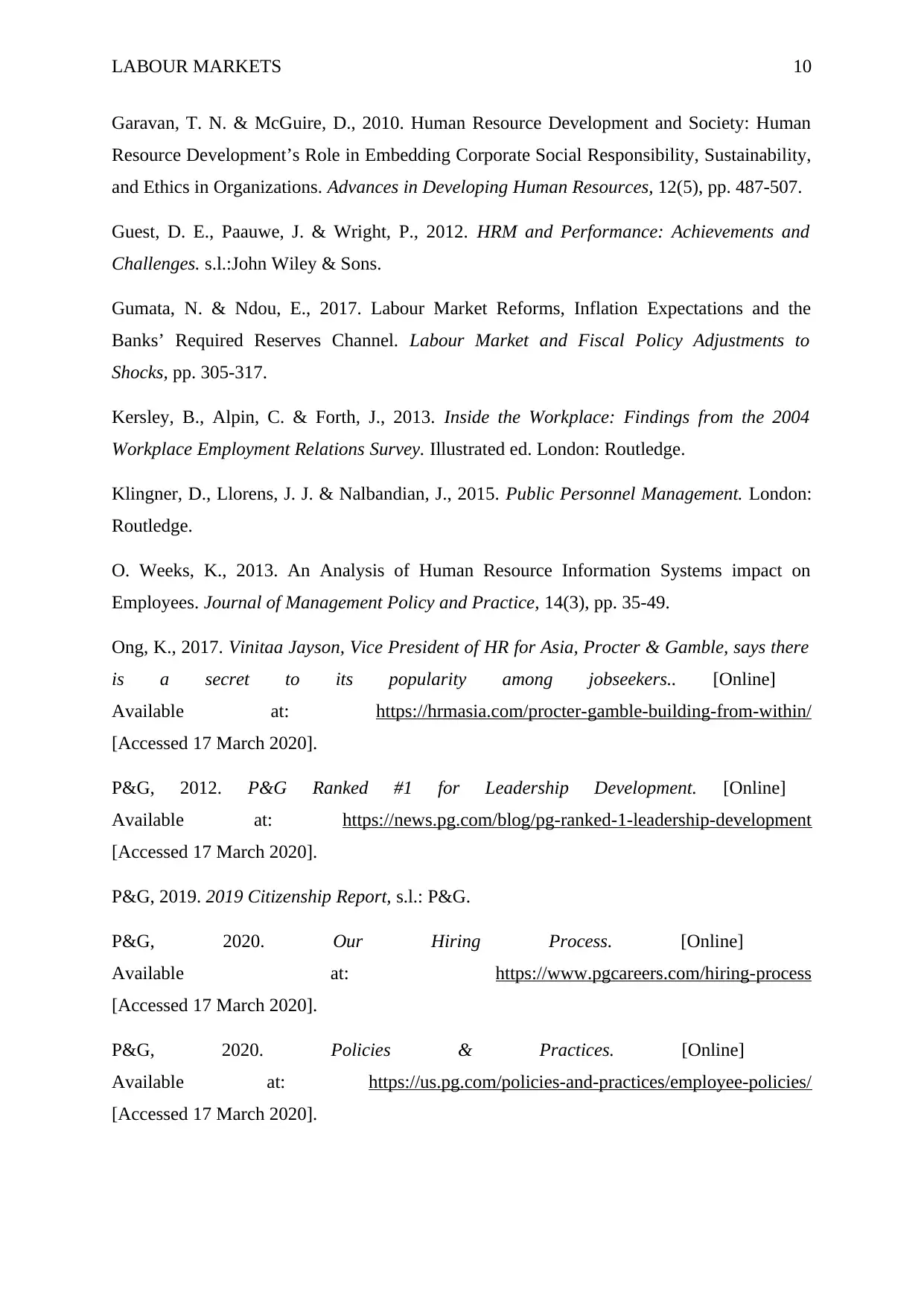
LABOUR MARKETS 10
Garavan, T. N. & McGuire, D., 2010. Human Resource Development and Society: Human
Resource Development’s Role in Embedding Corporate Social Responsibility, Sustainability,
and Ethics in Organizations. Advances in Developing Human Resources, 12(5), pp. 487-507.
Guest, D. E., Paauwe, J. & Wright, P., 2012. HRM and Performance: Achievements and
Challenges. s.l.:John Wiley & Sons.
Gumata, N. & Ndou, E., 2017. Labour Market Reforms, Inflation Expectations and the
Banks’ Required Reserves Channel. Labour Market and Fiscal Policy Adjustments to
Shocks, pp. 305-317.
Kersley, B., Alpin, C. & Forth, J., 2013. Inside the Workplace: Findings from the 2004
Workplace Employment Relations Survey. Illustrated ed. London: Routledge.
Klingner, D., Llorens, J. J. & Nalbandian, J., 2015. Public Personnel Management. London:
Routledge.
O. Weeks, K., 2013. An Analysis of Human Resource Information Systems impact on
Employees. Journal of Management Policy and Practice, 14(3), pp. 35-49.
Ong, K., 2017. Vinitaa Jayson, Vice President of HR for Asia, Procter & Gamble, says there
is a secret to its popularity among jobseekers.. [Online]
Available at: https://hrmasia.com/procter-gamble-building-from-within/
[Accessed 17 March 2020].
P&G, 2012. P&G Ranked #1 for Leadership Development. [Online]
Available at: https://news.pg.com/blog/pg-ranked-1-leadership-development
[Accessed 17 March 2020].
P&G, 2019. 2019 Citizenship Report, s.l.: P&G.
P&G, 2020. Our Hiring Process. [Online]
Available at: https://www.pgcareers.com/hiring-process
[Accessed 17 March 2020].
P&G, 2020. Policies & Practices. [Online]
Available at: https://us.pg.com/policies-and-practices/employee-policies/
[Accessed 17 March 2020].
Garavan, T. N. & McGuire, D., 2010. Human Resource Development and Society: Human
Resource Development’s Role in Embedding Corporate Social Responsibility, Sustainability,
and Ethics in Organizations. Advances in Developing Human Resources, 12(5), pp. 487-507.
Guest, D. E., Paauwe, J. & Wright, P., 2012. HRM and Performance: Achievements and
Challenges. s.l.:John Wiley & Sons.
Gumata, N. & Ndou, E., 2017. Labour Market Reforms, Inflation Expectations and the
Banks’ Required Reserves Channel. Labour Market and Fiscal Policy Adjustments to
Shocks, pp. 305-317.
Kersley, B., Alpin, C. & Forth, J., 2013. Inside the Workplace: Findings from the 2004
Workplace Employment Relations Survey. Illustrated ed. London: Routledge.
Klingner, D., Llorens, J. J. & Nalbandian, J., 2015. Public Personnel Management. London:
Routledge.
O. Weeks, K., 2013. An Analysis of Human Resource Information Systems impact on
Employees. Journal of Management Policy and Practice, 14(3), pp. 35-49.
Ong, K., 2017. Vinitaa Jayson, Vice President of HR for Asia, Procter & Gamble, says there
is a secret to its popularity among jobseekers.. [Online]
Available at: https://hrmasia.com/procter-gamble-building-from-within/
[Accessed 17 March 2020].
P&G, 2012. P&G Ranked #1 for Leadership Development. [Online]
Available at: https://news.pg.com/blog/pg-ranked-1-leadership-development
[Accessed 17 March 2020].
P&G, 2019. 2019 Citizenship Report, s.l.: P&G.
P&G, 2020. Our Hiring Process. [Online]
Available at: https://www.pgcareers.com/hiring-process
[Accessed 17 March 2020].
P&G, 2020. Policies & Practices. [Online]
Available at: https://us.pg.com/policies-and-practices/employee-policies/
[Accessed 17 March 2020].
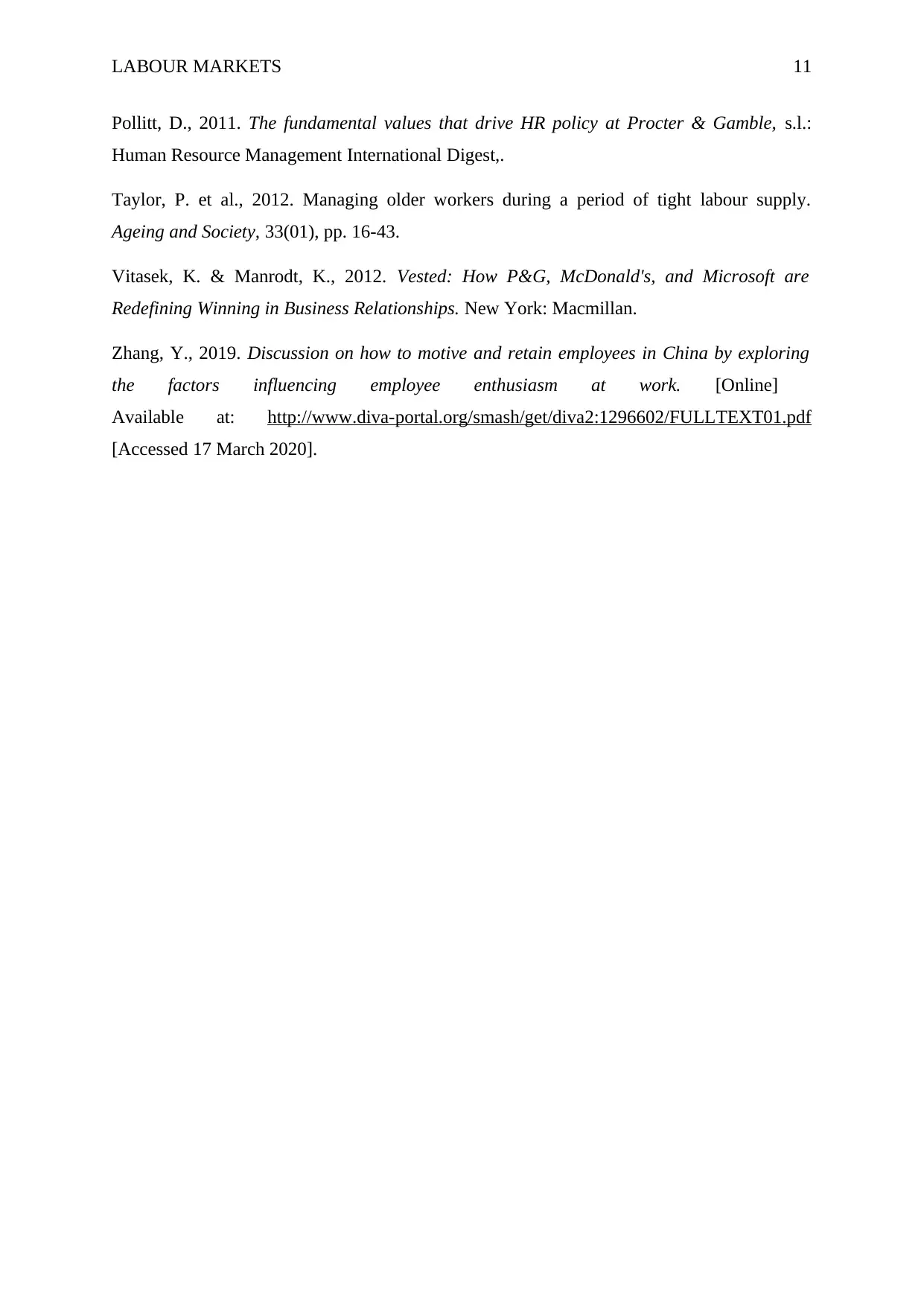
LABOUR MARKETS 11
Pollitt, D., 2011. The fundamental values that drive HR policy at Procter & Gamble, s.l.:
Human Resource Management International Digest,.
Taylor, P. et al., 2012. Managing older workers during a period of tight labour supply.
Ageing and Society, 33(01), pp. 16-43.
Vitasek, K. & Manrodt, K., 2012. Vested: How P&G, McDonald's, and Microsoft are
Redefining Winning in Business Relationships. New York: Macmillan.
Zhang, Y., 2019. Discussion on how to motive and retain employees in China by exploring
the factors influencing employee enthusiasm at work. [Online]
Available at: http://www.diva-portal.org/smash/get/diva2:1296602/FULLTEXT01.pdf
[Accessed 17 March 2020].
Pollitt, D., 2011. The fundamental values that drive HR policy at Procter & Gamble, s.l.:
Human Resource Management International Digest,.
Taylor, P. et al., 2012. Managing older workers during a period of tight labour supply.
Ageing and Society, 33(01), pp. 16-43.
Vitasek, K. & Manrodt, K., 2012. Vested: How P&G, McDonald's, and Microsoft are
Redefining Winning in Business Relationships. New York: Macmillan.
Zhang, Y., 2019. Discussion on how to motive and retain employees in China by exploring
the factors influencing employee enthusiasm at work. [Online]
Available at: http://www.diva-portal.org/smash/get/diva2:1296602/FULLTEXT01.pdf
[Accessed 17 March 2020].
⊘ This is a preview!⊘
Do you want full access?
Subscribe today to unlock all pages.

Trusted by 1+ million students worldwide
1 out of 12
Related Documents
Your All-in-One AI-Powered Toolkit for Academic Success.
+13062052269
info@desklib.com
Available 24*7 on WhatsApp / Email
![[object Object]](/_next/static/media/star-bottom.7253800d.svg)
Unlock your academic potential
Copyright © 2020–2025 A2Z Services. All Rights Reserved. Developed and managed by ZUCOL.





